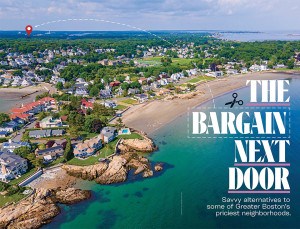A Tale of Two Rivers

While swimming is not permitted in the Charles, nearly 300 people jumped in one afternoon this summer as part of an event hosted by the Charles River Conservancy. / Photograph by Topher Baldwin/Charles River Conservancy
Hard as it may be to believe, the Charles and the Mystic started out on equal footing. They were both fertile fishing grounds that Native Americans stewarded for thousands of years. Then the first waves of European settlers arrived, and the rivers went to hell.
During the 1600s, the wide, deep swath of the Mystic near the present-day Blessing of the Bay Boathouse, in Somerville, is where some of the first tall ships built in the New World took to water. The inaugural vessel launched here belonged to John Winthrop, the first governor of the Massachusetts Bay Colony, and set out on its maiden voyage in 1631. Soon enough, shipbuilders flocked to the shores of the Mystic to take advantage of its strong tides and proximity to the ocean. Meanwhile, over on the Charles, the population of settlers was growing and the landscape was morphing. Businesses opened, trade picked up, and ships carrying loads of textiles, timber, and molasses became regular fixtures on the quiet backwaters that fed into the harbor.
As the American colonies coalesced, the two rivers served as a commercial and cultural backbone for the fledgling nation. The waterways were bloody flash points during the Revolutionary War, and later inspired the region’s artists; in Lydia Maria Child’s classic 1844 poem “Over the River and Through the Woods,” the river she so excitedly traverses is the Mystic. Henry Wadsworth Longfellow, on the other hand, preferred the Charles, as evidenced in his 1842 poem “To the River Charles,” in which he likens it to “the stream of life.”
In reality, by the time these poets were drawing inspiration from the rivers, both bodies of water were trashed with the heavy metals and toxic chemicals from America’s first industrial boom. By 1865, Woburn was home to more than 20 leather tanneries, one of the most environmentally hazardous cottage industries a city could embrace, and the chemical runoff began slowly migrating through the Mystic River Watershed. Life wasn’t any better on the Charles: The Boston Board of Health in 1872 issued a report describing the river as being “enveloped in an atmosphere of stench so strong as to arouse the sleeping, terrify the weak, and nauseate and exasperate nearly everybody.”
In the late 19th century the two rivers’ stories diverged. It started when the state and the city decided to turn the Charles’s Back Bay from a shallow cesspool into an upper-crust neighborhood. Between 1857 and 1900, construction crews filled in the polluted mud flats, erected elegant brownstones, and outfitted the new neighborhood with world-class public amenities, including the Museum of Fine Arts and the Boston Public Library. “Industry faded faster along the Charles,” says Robert Allison, a history professor at Suffolk University. “The Back Bay was created to be an enclave of wealth.”
Not long after the Back Bay was completed, Boston ensured that the town’s movers and shakers had access to the Charles, setting aside a long stretch of the waterfront that would eventually become the Esplanade and link together large portions of the city’s parkland. Over on the other side of the river, in Cambridge, the footprint of Harvard University continued expanding, and MIT opened its new campus just down the shoreline in 1916.
The towns in the Mystic River Watershed weren’t so lucky. Instead of parks and elite institutions, they got a Converse rubber plant, a Monsanto sulfuric acid plant, a Ford assembly line, and the highest-capacity power plant in Massachusetts. During World War II, the Mystic was less a river and more a pipeline for the war effort. In the following decades, white flight hit the area: The outer suburbs swelled with the new middle class while cities such as Chelsea, East Boston, and Somerville filled with poorer Asian and Latino immigrants who didn’t have the political capital or financial resources to beat back the tide of industrial pollution.
With the Mystic carrying Boston’s commercial payload, the Charles was ready for its second act. There was just one major problem: It was still full of sewage.
On October 22, 1995, as rowers from around the world came to Boston to compete in the Head of the Charles Regatta, John DeVillars brooded. The river was in terrible shape and DeVillars, head of the EPA’s New England division, wanted everyone to know it. In hopes of grabbing some headlines, he issued a provocative press release stating that the Charles was “notable not for its recreational potential but for the stench of sewage.” He then boldly predicted that under his direction the EPA would resurrect the Charles River and have it fit for swimming within a decade.
It sounded ludicrous, but DeVillars, an appointee of President Bill Clinton with degrees from Harvard and Penn, knew that the Charles’s problems were already on their way to being fixed. Thanks to a federal lawsuit filed the previous decade, the court had ordered the state to build the $3.8 billion Deer Island Sewage Treatment Plant to process the steady stream of raw sewage that overflowed into the Charles from the city’s ancient sewer system.
That alone wasn’t a cure. DeVillars still had to contend with illegal dumping all throughout the Charles River Watershed. It was common to find apartment buildings in Brookline, Watertown, or Milford with plumbing systems that flowed to the Charles. These jerry-built pipelines were public enemy number one as far as DeVillars was concerned. To take them down, he knew he needed to become the Eliot Ness of environmental law. “The EPA was more or less saying, ‘Pretty please, won’t you obey the law?’” DeVillars tells me. “After enough pretty pleases, it was time to take enforcement action.”
Among the first targets the EPA went after was Brookline, a wealthy suburb with a politically active tax base that would be loath to see a lawsuit over their waste play out in the news. It was the exact type of high-profile case DeVillars needed to kick-start the agency’s crackdown. “That enforcement action against Brookline was the shot heard ’round the Charles,” he says. The EPA’s willingness to go hard at Brookline was a wake-up call to nearby cities, and suddenly public works departments throughout the watershed were willing to work with the EPA in order to avoid costly lawsuits, hefty fines, and bad press.
In another display of its newfound regulatory might, the EPA took Boston University to task for two oil spills that had recently occurred in the Charles. As a result, the school had to cough up $771,000 to settle the case—the largest environmental penalty ever levied against an educational institution at the time. It wasn’t long before Harvard announced that it was voluntarily launching a new strategy to mitigate runoff into the Charles.
DeVillars notes that the agency didn’t rely solely on the stick of enforcement to get results. It gave ample warning to violators to get on board before it was too late. After all, he’d much rather fix the problem than stuff the EPA’s docket with legal battles that could go on for years.
The one-two punch of relentless enforcement and infrastructure upgrades worked almost immediately. In 1999, the Charles was safe enough to swim in 65 percent of the time, up from just 19 percent four years earlier. In 2004, nine years after DeVillars promised a swimmable Charles, the river scored its first B+ ranking from the EPA. Looking back, DeVillars, who left the agency in 2000, describes the Charles as a laboratory in which the EPA was able to test legal pressure points, experiment with media strategies, and piece together broad coalitions. He had only one shot to prove that urban rivers could be quickly and dramatically revived, and he succeeded. Today, he stops short of saying it was easy, but he emphasizes that the EPA has in its arsenal some of the toughest environmental laws in the world. “The laws that were on the books in the 1990s when we began the Charles initiative are still on the books today,” he says. “It’s a question of using those tools as ambitiously and effectively as possible.”
While DeVillars led the charge on the Charles, though, the Mystic still suffered. It was out of sight, out of mind. “The Charles was the primary if not sole focus,” he says. “People come from all over the world to go to universities here or get medical care here or come for business here, and the Charles River is an important part of the image of Boston.” It wasn’t a hard choice, DeVillars says. The Charles was simply more marketable than the Mystic.
The Mystic River needs a John Devillars. Critics say the EPA has failed time and again to take meaningful enforcement actions against chronic polluters in the lower basin, where large parts of the waterway are state-zoned “Designated Port Areas” and development is restricted to water-intensive commercial pursuits.
There’s little denying that companies occupying these lots play an essential role in Boston. We can’t have a functioning international airport if we don’t have an easy way to ship in the jet fuel and store it. We can’t keep the roads clear in the winter if we don’t have a channel deep enough to hold the giant ocean liners that haul several tons of salt across the Atlantic. But there’s a right way to accommodate these activities, and at this moment things along the lower Mystic are far from right.

